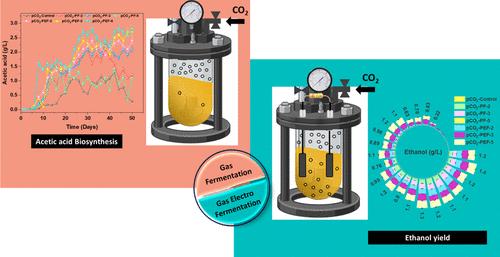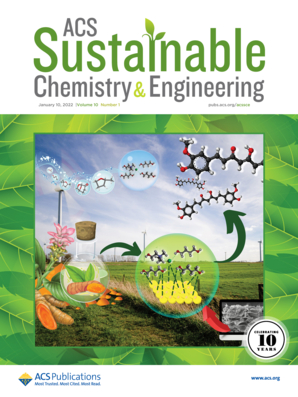Electrode-Assisted Pressurized CO2 Fermentation for Acetic Acid and Ethanol Production: Enhanced Carbon Fixation, Metabolic Efficiency, and Sustainability in Carbon-Negative Bioprocesses
IF 7.1
1区 化学
Q1 CHEMISTRY, MULTIDISCIPLINARY
引用次数: 0
Abstract
Gas fermentation using homoacetogenic consortia to convert CO2 into sustainable fuels and chemicals has emerged as a promising biotechnological route toward carbon neutrality. However, a significant challenge is the low gas–liquid mass transfer rates due to the limited solubility of C1 gases. This study investigates CO2 fermentation enhancement using a high-pressure gas fermentation (HPGF) reactor embedded with electrodes, effectively overcoming CO2 solubility barriers and addressing sustainability through an innovative approach. CO2 fermentation with H2 as the electron donor was conducted in pressurized fermenters (PFs) at varying partial pressures (pCO2-2, -3, and -5 bar), while pressured electro-fermentation (PEF) used electrodes to replace H2. The pCO2-PEF-5 condition achieved the highest acetic acid productivity of 2.8 g/L, followed by pCO2-PEF-3 at 2.65 g/L, representing 1.2 and 1.18 times higher yields than the best condition of PFs (pCO2-PF-3, 2.1 g/L), respectively. Additionally, PEF systems enhanced solventogenic activity, with ethanol production reaching 1.4 g/L in pCO2-PEF-5. The substitution of H2 with electrodes in CO2 fermentation improved fixation and conversion rates (pCO2-PEF-5: 67 mg/L/h, 77%), demonstrating a viable strategy for enhanced CO2 conversion. The thermodynamic analysis indicated more spontaneous synthesis of acetic acid and ethanol in PEF systems compared with PF systems. Bioelectrochemical assessments revealed higher charge transfer rates, with a faradaic efficiency of 48% in pCO2-PEF-5, further supporting CO2 conversion. Especially, key genes in the Wood–Ljungdahl pathway (WLP) were upregulated in PEF systems, confirming that electro-fermentation influences metabolic pathways favoring carbon fixation and solvent production. A life cycle assessment (LCA) highlighted a net emission reduction of −7 kg CO2 equiv in PEF-5 and lower impact across endpoint categories, highlighting the carbon-negative potential of this approach. From a planetary boundary framework perspective, this process operates within the Holocene state by reducing CO2 emissions, helps in maintaining biosphere integrity, reduces atmospheric CO2, and contributes minimally to nitrogen and phosphorus flows. This study signifies the sustainability of the PEF strategy for scaling CO2 conversion processes. The integration of electro-fermentation not only addresses mass transfer limitations but also enhances carbon fixation efficiency and metabolic productivity.

电极辅助加压CO2发酵用于醋酸和乙醇生产:增强碳固定,代谢效率和碳负生物过程的可持续性
利用同质产丙酮联合体将二氧化碳转化为可持续燃料和化学品的气体发酵已成为一种有希望实现碳中和的生物技术途径。然而,一个重大的挑战是由于C1气体的溶解度有限,气液传质速率低。本研究利用嵌入电极的高压气体发酵反应器(HPGF)研究了二氧化碳发酵的增强,有效克服了二氧化碳的溶解障碍,并通过创新的方法解决了可持续性问题。以H2为电子供体的CO2发酵在不同分压(pCO2-2, -3和-5 bar)的加压发酵罐(PFs)中进行,而加压电发酵(PEF)使用电极代替H2。pCO2-PEF-5条件的乙酸产率最高,为2.8 g/L,其次是pCO2-PEF-3,为2.65 g/L,分别是最佳条件pCO2-PF-3 (2.1 g/L)的1.2倍和1.18倍。此外,PEF系统增强了溶剂生成活性,在pCO2-PEF-5中乙醇产量达到1.4 g/L。在CO2发酵中,电极替代H2提高了固定和转化率(pCO2-PEF-5: 67 mg/L/h, 77%),证明了一种增强CO2转化的可行策略。热力学分析表明,PEF体系比PF体系更容易自发合成乙酸和乙醇。生物电化学评估表明,pCO2-PEF-5的电荷转移率更高,法拉第效率为48%,进一步支持了二氧化碳的转化。特别是,在PEF系统中,Wood-Ljungdahl途径(WLP)的关键基因被上调,证实了电发酵影响有利于碳固定和溶剂产生的代谢途径。生命周期评估(LCA)强调了PEF-5的净排放量减少了- 7千克二氧化碳当量,并且对端点类别的影响更低,突出了该方法的碳负潜力。从行星边界框架的角度来看,这一过程通过减少二氧化碳排放在全新世状态下运行,有助于维持生物圈的完整性,减少大气中的二氧化碳,并对氮和磷的流动贡献最小。这项研究表明了PEF策略在扩大二氧化碳转化过程中的可持续性。电发酵的集成不仅解决了传质限制,而且提高了固碳效率和代谢效率。
本文章由计算机程序翻译,如有差异,请以英文原文为准。
求助全文
约1分钟内获得全文
求助全文
来源期刊

ACS Sustainable Chemistry & Engineering
CHEMISTRY, MULTIDISCIPLINARY-ENGINEERING, CHEMICAL
CiteScore
13.80
自引率
4.80%
发文量
1470
审稿时长
1.7 months
期刊介绍:
ACS Sustainable Chemistry & Engineering is a prestigious weekly peer-reviewed scientific journal published by the American Chemical Society. Dedicated to advancing the principles of green chemistry and green engineering, it covers a wide array of research topics including green chemistry, green engineering, biomass, alternative energy, and life cycle assessment.
The journal welcomes submissions in various formats, including Letters, Articles, Features, and Perspectives (Reviews), that address the challenges of sustainability in the chemical enterprise and contribute to the advancement of sustainable practices. Join us in shaping the future of sustainable chemistry and engineering.
 求助内容:
求助内容: 应助结果提醒方式:
应助结果提醒方式:


